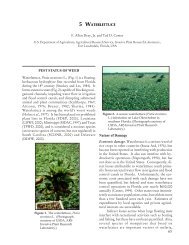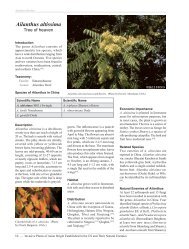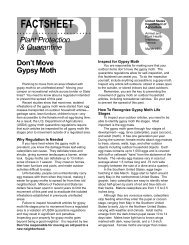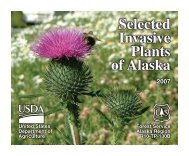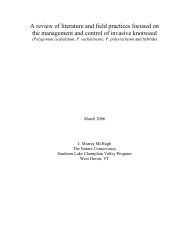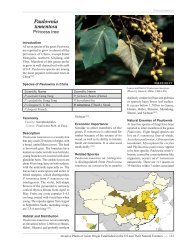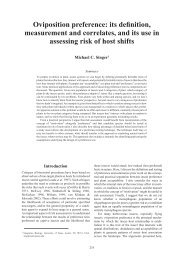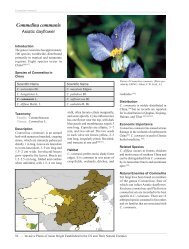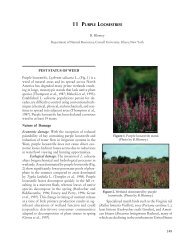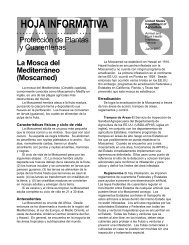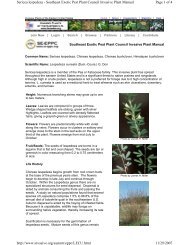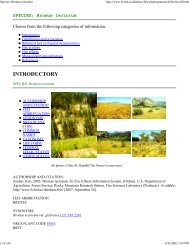A Guide to the Control and Management of Invasive Phragmites [PDF]
A Guide to the Control and Management of Invasive Phragmites [PDF]
A Guide to the Control and Management of Invasive Phragmites [PDF]
Create successful ePaper yourself
Turn your PDF publications into a flip-book with our unique Google optimized e-Paper software.
underst<strong>and</strong>ing phragmites<br />
control methods<br />
recommended management strategies<br />
fur<strong>the</strong>r information<br />
part 1<br />
part 2<br />
part 3<br />
part 4<br />
1<br />
Introduction<br />
An aggressive, nonnative variety <strong>of</strong> phragmites (<strong>Phragmites</strong> australis),<br />
also known as common reed, is threatening <strong>the</strong> ecological health<br />
<strong>of</strong> Michigan wetl<strong>and</strong>s <strong>and</strong> coastal shorelines.<br />
Because this guide discusses <strong>to</strong>ols<br />
that are not readily applied by <strong>the</strong><br />
average l<strong>and</strong>owner, it is intended<br />
primarily for l<strong>and</strong> or resource managers<br />
from agencies, organizations,<br />
<strong>and</strong> businesses <strong>and</strong> extension agents or<br />
o<strong>the</strong>rs in a similar position.<br />
left: Dense st<strong>and</strong> <strong>of</strong> phragmites that has<br />
displaced native vegetation. B. Avers<br />
This invasive variety <strong>of</strong> phragmites is<br />
becoming widespread throughout <strong>the</strong><br />
Great Lakes <strong>and</strong> is displacing <strong>the</strong> native<br />
variety <strong>of</strong> <strong>the</strong> same species, as well as<br />
many o<strong>the</strong>r native plants. Near-monotypic<br />
st<strong>and</strong>s <strong>of</strong> this phragmites have<br />
replaced high-quality, complex communities<br />
<strong>of</strong> native plants over thous<strong>and</strong>s <strong>of</strong><br />
acres <strong>of</strong> Michigan wetl<strong>and</strong>s <strong>and</strong> coastal<br />
areas. The rapid expansion <strong>of</strong> this variety<br />
<strong>of</strong> phragmites has resulted in adverse<br />
ecological, economic <strong>and</strong> social impacts<br />
on <strong>the</strong> natural resources <strong>and</strong> people <strong>of</strong><br />
<strong>the</strong> Great Lakes.<br />
The goal <strong>of</strong> this guide is <strong>to</strong> provide<br />
information about effective methods <strong>to</strong><br />
control <strong>and</strong> manage phragmites. This<br />
guide presents a compilation <strong>of</strong> techniques,<br />
based on four years <strong>of</strong> research<br />
<strong>and</strong> more than 10 years <strong>of</strong> l<strong>and</strong> managers’<br />
on-<strong>the</strong>-ground experience, <strong>to</strong><br />
control <strong>the</strong> nonnative variety <strong>of</strong> phragmites,<br />
hereafter referred <strong>to</strong> simply as<br />
phragmites. <strong>Control</strong> <strong>of</strong> phragmites is<br />
one step <strong>to</strong>ward a greater goal <strong>of</strong> res<strong>to</strong>ring<br />
native wetl<strong>and</strong> plant communities<br />
<strong>and</strong> protecting fish <strong>and</strong> wildlife habitat.<br />
The easiest way <strong>to</strong> control phragmites is<br />
<strong>to</strong> begin a control program as soon as it<br />
is observed on your property, before<br />
<strong>the</strong> plants become well established.<br />
In many areas, especially those with<br />
established phragmites, complete eradication<br />
may not be achievable. However,<br />
through periodic management, it is<br />
possible <strong>to</strong> maintain phragmites infestations<br />
at levels that allow for regeneration<br />
<strong>of</strong> native wetl<strong>and</strong> plant communities<br />
<strong>and</strong> protection <strong>of</strong> fish <strong>and</strong> wildlife<br />
habitat.


![A Guide to the Control and Management of Invasive Phragmites [PDF]](https://img.yumpu.com/27321025/6/500x640/a-guide-to-the-control-and-management-of-invasive-phragmites-pdf.jpg)

